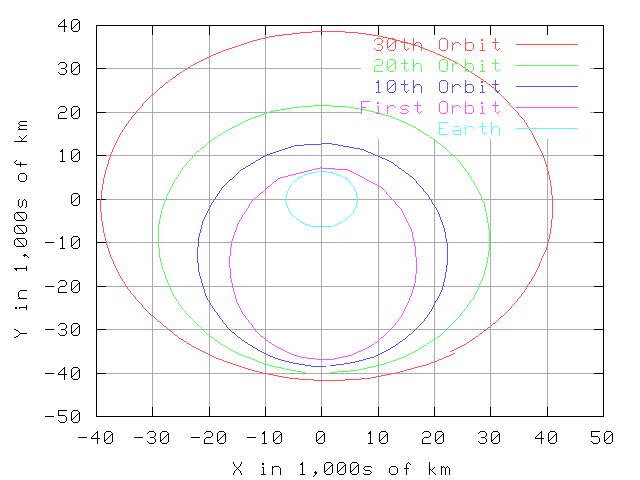Solar Sail
In CateCATS1 we plan to use one or more solar sails to provide the thrust
to reboost the GEO-Tether.
The first things that we send to GEO will be pulled there by solar sails
which will later be used to reboost the tether. Below is a graph
showing how a solar sail tossed from a LEO tether can climb to
GEO in about 16 days.

Our GEO-Tether is a rotating tether, which makes designing to use
a solar sail a bit tricky. The 2 designs currently
being considered to deal with the issues. The first is
"Team Pulling" where a number of solar sails out in front and
attached by long ropes to the center of mass of the GEO-Tether.
The second "Built In" is to have long skinny solar sails built into the
tether and able to twist around the tether to turn on and off
the thrust. These and the issues are discussed below.
Team Pulling Solar Sails
There is a hub near the center of rotation of the GEO-Tether.
A leash on the left and the right side of the hub goes to a set of solar sails.
The ones on the left stay to the left of the rotating GEO-Tether and
the ones to the right stay to the right.
The hub could move up and down if we want to use the thrust from the
solar sails to control the rotational momentum of the GEO-Tether.
The solar sails are operating in zero-gravity, as normal solar sails
are designed to do. This lets them be light weight.
Our estimate is 1,000 Kg per square kilometer of sail for this
type of design.
Motions are in 24 hour time scale as at GEO you are orbiting the
earth once every 24 hours and the sails need to orient themselves
relative to the Sun.
The orientation of the solar sail can be optimized to get
the most thrust using this design.
The failure modes of this approach could be an issue.
We have not fully simulated this approach and one of
the authors is worried that there could be complexity
in the control and dealing with waves/oscillations.
Built In Solar Sails
If we need 20 square kilometers of solar sail we can do
it as a sort of kite shape that is 200 kilometers long
and 200 meters wide in the middle, tapering down to a point
at the ends. This could be built in different sections
that could rotate independently about the tether.
Having the solar sail on a rotating tether means that
it is not in zero-G, which means it has to be stronger.
The natural way to design this is a single 200 meter
beam in the center and split the mass of the tether
into 2 tethers that go along the edges of the kite shape
like the strings that form the outside frame of a kite.
The solar sail membrane is then attached to this frame.
There could be a reaction wheels attached to the 200
meter beam and reaction wheels mid-way along each
half of the sail. With these 3 reaction wheels you
could control when the sail was catching sun and when
it was sideways to the sun. So you could turn the
thrust on and off for the whole solar sail or for
each half.
In this design the solar sail is rotating, so it does not
stay at the ideal angle to produce thrust.
With each rotation of the tether the solar sails would
twist, so the motion is much more often, like every
8 minutes. This probably requires a stronger solar sail,
and so more mass. A heavier sail means longer time
to launch, but beyond that it is not really a problem.
Additional mass just acts as part of the ballast to
store orbital energy, which is a good thing.
The failure modes seem less troublesome in this approach.
Towing Algorithm
As a first pass at a towing algorithm;
If a sail is towing, calculate the angle between the tow and the sail.
Set the sail angle such that the force of the sail is that angle,
or perhaps half way between that angle and the 'optimum force' angle.
(If the angles are close, half way would be OK. If not close, need to keep the tow tether tight.)
( May be best to scale between optimum and tow angle by the amount between;
If delta (tow / optimum force) angle < threshold, stick to optimum,
If delta > threshold, < worry, use pro-rated share of delta,
Else try to pull at tow angle.
Note - this discussion is the effective force angle, not the sail setting angle.
If tow velocity vector is within 5 degrees of 0 (into the sun - is that 180?) (half hour is 7.5 degrees at GEO)
Then cut thrust by 70% (to pretend to cant the sail in Z dimension), and bring the sail around the tow object.
When tow velocity vector is > 5 degrees off the sun, go back to the 'normal' algorithm.
Click for SpaceTethers.com
